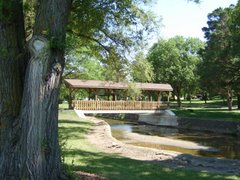(Ed.note: Click on the post for the web site for the Dixie Chicks.)
One of my favorite songs to warm up with on the Nordic Track is the Dixie Chicks song, "Everybody Knows." It is one those intermediate beat songs that lets me warm up in the early stages of a work out-----I never have concentrated on the lyrics before....just the beat...and... I really like the beat.
Recently, at the Public Works hearing when Joe DeYoung rose to speak about the engineering study MSA did on the West side, he said that "there was no surprises." "It was what we expected." Search on the blog for the video.
All during his speech, up next to the easel, with the black suit, I started hearing the Dixie Chicks-----singing "Everybody Knows." ------that love song classic about stepping out and knowin that everybody knows about the cheatin... about...feeling terrible because "Everybody Knows," despite all the way "this game of life" is played.
I thought it was kinda unusual. A one of a kind experience. Hearing the Dixie Chicks and all. I usually only hear them when I have my IPOD turned up REAL loud in the middle of intense..... or kinda intense..... excercise, such as it is.
Last week.... right in the middle of a video spot with the Seniors..... right in the middle of the ultimate test of a reporter, namely could I still eat some chicken legs while doing audio and video simultaneously...right after someone behind me asked whether the site for the new senior center was in the flood plain.....I started hearing the Dixie Chicks again....and they were singing real loud......"Everybody Knows."
All of a sudden---I started really hearing the lyrics.
And it got pretty loud..I mean the Dixie Chicks were singing very loud indeed. In fact I got to thinking. I wonder if the Dixie Chicks knew that "Everybody Knew" and could care less. Yes.
"Everybody Knows" plus building on a flood plain with donor dollars, and with the donor representative present, and with all the consultants present and praising all who paid them profusely.......and with all the board present and many of the seniors present, and after only one or maybe two cocktails.......
"Everybody Knows."
Still I had to wonder.
How does someone from TEXAS know anything about a flood plain?
Tuesday, January 01, 2008
OpEd: Reflection: "Everybody Knows"----the song: "Everybody Knows"-----the Senior Center
Subscribe to:
Post Comments (Atom)






























The Observer becomes extremely nervous whenever he hears the term "flood plain," as if that is a harbinger of doom. Not so.
ReplyDeleteA flood plain consists of two parts, a floodway and a 100-year flood fringe. Constructing structures in a floodway is prohibited. Constructing structures in flood fringe is permitted. You just have to purchase flood insurance. Furthermore, you can remove a building site from the flood fringe, and thereby avoid needing to purchase flood insurance. All you have to do is obtain a building permit, add fill to the site to bring it two feet above the 100 year flood elevation, apply for and obtain an amendment to the flood plain map to exclude the building site from the flood fringe, and then construct the structure. That is what is being proposed for the new senior center site.
What happened on the west side of Evansville demonstrates how and how not to handle construting in a flood fringe. The engineers for the developers of the Westfield Meadows Subdivision recognized the flood fringe issue in that area, and they took the necessary precautions to deal with the situation. But earlier, when the Abey-Koth Subdivision was platted, neither the developer's nor the city's engineers recognized the flood fringe issue, and consequently the city is trying, after the fact, to protect homes in that subdivision from flooding.
It is ignornant to hear "flood plain" and think "don't build."
Bill Connors
I love it when you plead in the alternative----let's get flood insurance and control the risk, or,,,,,,,,, then again we could raise it two feet and cut costs by putting the complete investment at risk with no flood insurance. That way if one misjudged the risk, it is a major loss. Great thinking. "Making a silk purse out of a sow's ear thinking.
ReplyDeleteThere is plenty of land around. Build on high ground. The service area for the seniors is the territory of the school district. The current board did a good job of focusing on the needs of the seniors in the design. I am suggesting they should do the same good job in adjusting the building to the site.
The word is not "nervous"--it is "prudent." As in standard of care.... When one is a senior and the product is for seniors, one should consider whether a donor would be comfortable with investing major amounts of money for a facility that is uninsurable" for flood risk, if the lawyers and engineers can arrange it that way.
I would not suggest that seniors day trade oil futures. Maybe you think this is appropriate too.
A lot of prime real estate in downtown Evansville is in the flood fringe, e.g, the properties along Union Street north of the lumber yard. Saying "build elsewhere" is the same thing as saying "board up downtown Evansville." Furthermore, a downtown location would be the most convenient for seniors. Following the recognized legal and engineering standards for removing a building site from the flood fringe is not accepting the kind of risk that is inherent in trading oil futures. There is a big difference between levels of risk in various activities, and some risks are worth taking. But the Observer appears to think any risk is unacceptable.
ReplyDeleteBill Connors
When its tax payer dollars at stake, any risk is to much.
ReplyDeleteBuild on high ground.
WHO owns this land they want to build on.
Is this just typical Evansville politics?
why are we putting the fire station where they are?
Buying all that land and most is unusable as it is in a flood plain.
Since when is it "tax payer's dollars" at risk? From what I can tell this project will be funded on the private dime. No?
ReplyDeletetax payer risk for alot of the down town projects is what I meant.
ReplyDeleteI do yes believe the senior project is private.
But regardless why ON A FLOOD PLAIN.
somebody is profiting from this very dangerous choice.
I wonder if the person(s) who donated the money would approve of where they are choosing to build.
do you remember where the bauer house used to be , before it was burned down?
That is a flood plain, with a big old for sale sign in front of it.
a area where the city has talked about helping whom ever would be foolish enough to build there, help them with money to put something there.
Maybe they could open up a canoe and life jacket store.
same thing with the fire station location.
At least there should not be a shortage of water, and that is tax payer funded.
what a waste of money.
how much extra is it going to take to flood proof the land the senior ctr group is looking to build on.
I smell something funny about this project. With all the available space/land in this town and they pick there.
Most of the sites that have the highest potential for redevelopment in TID No. are in the flood fringe. If the city does not soon attract some major redevelopment projects in TID No. 5, which almost certainly would require redevelopment of sites in the flood fringe, it is likely that TID No. 5 will not meet its financial projections. If TID No. 5 does not meet its projections, and the city will need to increase property taxes or cut spending to make up for the tax increment that will not be generated. How do you like that risk, Anonymous?
ReplyDeleteConstructing a new senior center on the old co-op site probably would not generate any tax increment, because it probably will be owened by the city or a not-for-profit organization. But it might generate more economic activity in downtown Evansville, which would enhance the viability of increment-generating redevelopment projects in TID No. 5.
Bill Connors
In the very first post, Mr. Connors said:
ReplyDeleteA flood plain consists of two parts, a floodway and a 100-year flood fringe. Constructing structures in a floodway is prohibited. Constructing structures in flood fringe is permitted. You just have to purchase flood insurance. Furthermore, you can remove a building site from the flood fringe, and thereby avoid needing to purchase flood insurance. All you have to do is obtain a building permit, add fill to the site to bring it two feet above the 100 year flood elevation, apply for and obtain an amendment to the flood plain map to exclude the building site from the flood fringe, and then construct the structure. That is what is being proposed for the new senior center site."
I visited with Mr. Phil Kress today, member of the site committee and formerly with the State Ins. Dept and who knows flood insurance, and he said that there is no suggestion that with enhanced flood protection to elevate the building that the building would not be flood protected by flood insurance--the insurance would be cheaper...much cheaper. The building would be insured for flood risk. He said he would send some general info on flood insurance for publication.
I agree with Mr. Connors that many development areas under discussion for economic development involve calculation for flood risk. This calculation and discussion will be a frequent one moving forward.
Folks who discuss the risks involved cannot be simply smeared or branded---in this specific case it is clear by anyone who views the video that there were elements that the board had not been informed of fully. The citizens asked the questions. I just shot the video.
It does not surprise me that one can purchase flood insurance for a building constructed on a site that was once in the flood fringe but was raised above the flood elevation and removed from the flood plain on the official map before construction. Heck, one probably can purchase flood insurance for a building located anywhere. I was attempting to communicate, perhaps inarticulately, that flood insurance is no longer REQUIRED if the site is raised above the flood elevation and removed from the flood plain in the official map.
ReplyDeleteObserver, if you feel my initial post "smeared" you, I am sorry, that was not my intent. But your initial post appeared intended to suggest that is was utter folly to even consider constructing a building in a flood plain. There is a big difference between asking if the proposed site is in the flood plain and what the ramifications of that are, and writing that "everybody knows" bad things will happen if the senior center is built on the proposed site yet the Friends are proceeding blindly forward. I think it is reasonable that someone would read your initial post to communicate that message.
Bill Connors
So the proposed Senior Center property doesn't have enough soil and Lake Leota has too much.
ReplyDeleteHmmmmm.....
Flood insurance from my perspective:
ReplyDeleteAs we know from last summer’s experience, flooding includes water from a sudden downpour or persistent rain – in addition to the overflow of a body of water. Furthermore, property insurance policies have exclusions for water damage resulting from all types of flooding. However, the National Flood insurance Plan (NFIP) provides at least some coverage for water-risk that is excluded from the homeowner’s and commercial policies.
Flood insurance is available for properties in Rock County, even properties that are far from an official floodplain. As with other property insurance, when the risk of loss is lower the flood insurance premium is smaller. In other words, the flood insurance premium is less expensive for a property some distance from a river or at slightly higher elevations than it would be for those properties in mandatory flood insurance areas. See the NFIP and Insurance Commissioner’s sites referenced below.
Almost any property in our area has a potential for water damage. Examples include: water running in basement windows from sudden/localized downpours, collapse of a basement wall from the pressure of saturated soils, and flood damage from persistent rains that overwhelm drainage systems as occurred in Evansville last August. Over the last decade or so I recall other similar events occurring in Waukesha, Delevan and Madison. In each of these examples flood damage occurred even though the buildings that were damaged were not near a body of water or in even in a floodplain – it is likely that each of the properties damaged could have been insured for some of their loss with flood insurance. It seems that most property, even if it is on what seems to be higher ground has the potential for water damage loss that is not covered by standard property insurance.
Of course property near a stream has the additional potential that the banks could overrun and flood a building. As for property everywhere in Wisconsin, the owner of property near a stream also needs to understand the risk, manage the estimated risk, and for the risk that remains consider the flood insurance option.
During my previous work with the state’s insurance commission, I advised home and commercial property owners to understand the risk of loss from water damage, understand the standard exclusion of coverage, and make an informed decision about purchasing or not purchasing flood insurance.
It’s appropriate to assume that flood insurance is available for home and business properties anywhere in Evansville.
For information about flooding and flood insurance, there is FEMA’s National Flood Insurance Site, www.floodsmart.gov. Insurance agents are available to help with flood insurance purchases. Check general information on the Insurance Commissioner’s website, www.oci.wi.gov. There is a Consumer's Guide to Homeowner's Insurance that is a good start. [P.S. Wisconsin might be the least expensive state (or close to the least expensive) for homeowner’s insurance coverage and is among the ten least expensive states for automobile insurance.]
Phil Kress
Good analysis, Phil. Add to that the steps that Public Works is taking to improve the rating of the city for flood insurance premiums.
ReplyDeleteIt's about taking steps to minimize risk and protect against threats. If we'd had these discussins before Abey-Koth was developed last Summer may have played out differently.